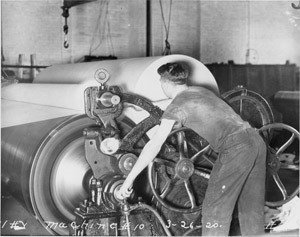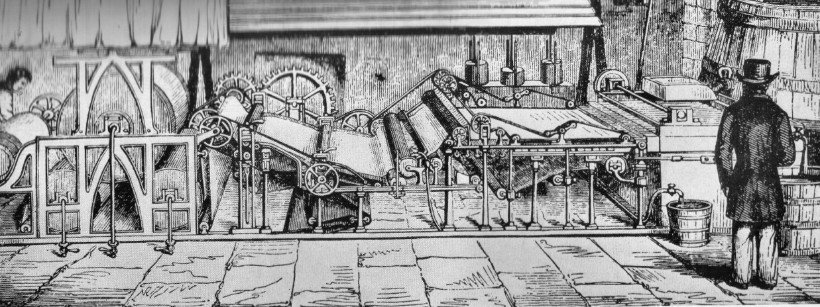The paper industry
Presentation by : hailee, jeffrey, and tristin.
The pulp and paper industry consists of companies that use wood as raw material and produce pulp ( Which is a chemically fibrous material. as well as one of the most abundant raw materials ) , paper, board and other cellulose-based products make up the industry. & the production of paper. The pulp and paper industry remain to be one of the most significant industries in the US.

https://www.youtube.com/watch?v=o9jC78x3KuI
paper pre- & post the 19th century.
The birth of paper, took place under the Chinese Han dynasty in AD 105. The paper-making process then consisted of the development of specialties made in progressing paper and developing ways to advance the production. The pre dominant raw material used for paper at this time was rags, before further advancements were being contemplated. Alternate ways of creating paper were contrived as quicker and more assured ways of creating paper became easier as it spread. The supply in demand for paper relied on the improvements of paper making. By the 16th and 17th century, papermaking technology improves. Technical progress continued throughout the 17th century to the 18th century. Relating in time with the beginning of the industrial revolution.
How does the paper industry relate to the industrial revolution ?
The Industrial revolution was a time of drastic change and transformation from hand tools, and hand made items to machine manufactured and mass produced goods. Mass production had begun, along with capitalism. The paper industry relates to the industrial revolution because around the time advancements were being made, it lead to the production of machines. & newer inventions. The new machinery made a drastic change for the demand in paper, when it was easier to make in a faster and more reliable way.
inventions that improved paper making.
- Hollander beater
Much more efficient way to make pulp compared with the stamping mill, which it began to replace, dividing papermakers into traditional versus modern camps.
- Stamping mill
is a type of mill machine that crushes material by pounding rather than grinding.
Meanwhile, improvements in the printing process, namely the introduction of movable type, greatly increased demand for paper. It led to a serious shortage of raw materials and to regulations governing the trade in rags, the primary raw material for making paper.
Who made the first paper making machine ?
-
In 1799, Louis nicolas Robert patented the first machine to produce 'continuous paper'.

Significance of the paper industry.
Importance of paper to US society.
Paper allows us to record our thoughts & ideas with ease. Without paper being involved in ours life's, the effort to make it would be lost. Resulting in machinery, & inventions to lose it's importance. Without paper being demanded from the beginning, advancements would have been ignored completely. Paper became a simpler way in recording our thoughts, as well as it's needed for printing, and media for our own entertainment. The industry allows us to have something we typically overlook in importance to our everyday live's.
Countries involved.
- North America ( US & Canada. ) Northern Europe, ( Finland, Sweden, and northwest Russia such as east Siberian Russia, China, Japan, and south Korea, Australia, and brazil. )
- North America and Nothern Europe dominate the paper industry.
- North America is number one in the paper industry.
Why some consider this an unfair trade ?
Some consider paper an environmental impact.
- The production and use of paper has a number of adverse effects on the environment which are known collectively as paper pollution. Pulp mills contribute to air, water and land pollution. Discarded paper is a major component of many landfill sites. Even paper recycling can be a source of pollution due to the sludge produced during de-inking.
- Pulp and paper is the third largest industrial polluter to air, water, and land in both Canada and the United States, and releases well over 100 million kg of toxic pollution each year.
- Worldwide, the pulp and paper industry is the fifth largest consumer of energy, accounting for four percent of all the world's energy use. The pulp and paper industry uses more water to produce a ton of product than any other industry
Deforestation, air pollution, water pollution.


- A large proportion of female workers in the paper industry in the 1800s were young, unmarried women.
Paper Is One Of The Few Truly Sustainable Products
Sustainability Facts
- Paper is based on wood, a fully renewable and sustainable resource.
- Forest certification ensures wood comes from well managed forests.
- Paper production is not a major cause of deforestation globally.
- Responsible wood, pulp and paper production ensures healthy growing forests.
Paper is sustainable, useful, & purposeful.
Though we could make some changes in the effects it causes to the environment, paper is needed. We condone the continuing of the manufacturing of paper, because paper is so significant to us. As we use it everyday.
http://www.paperbecause.com/media/jason-and-the-paperless-workplace
Paper is an amazing product: it is renewable, clean and incredibly versatile. It continuously offers new possibilities, applications and end-uses.
The continuous evolution of paper technology and production processes has increased speed, productivity and enhanced production quality whilst becoming increasingly responsive to environmental concerns. New technologies are in place to make paper lighter, reduce energy consumption and to generate biofuels. The paper industry remains to be one of the most successful industries in the US because of it's demand, and multiple uses. Paper is needed almost consistently throughout the day.
Sources.
- http://www.ipst.gatech.edu/amp/collection/museum_paper_lives.htm
- http://www.twosides.info/Paper-Is-Bad-For-The-Environment
- http://www.paperonline.org/history-of-paper